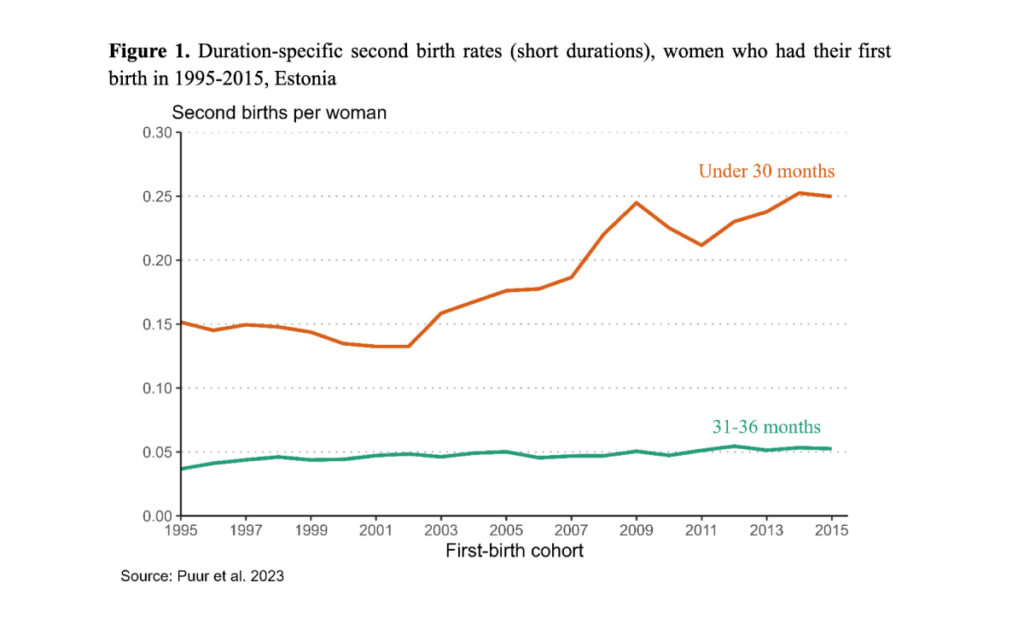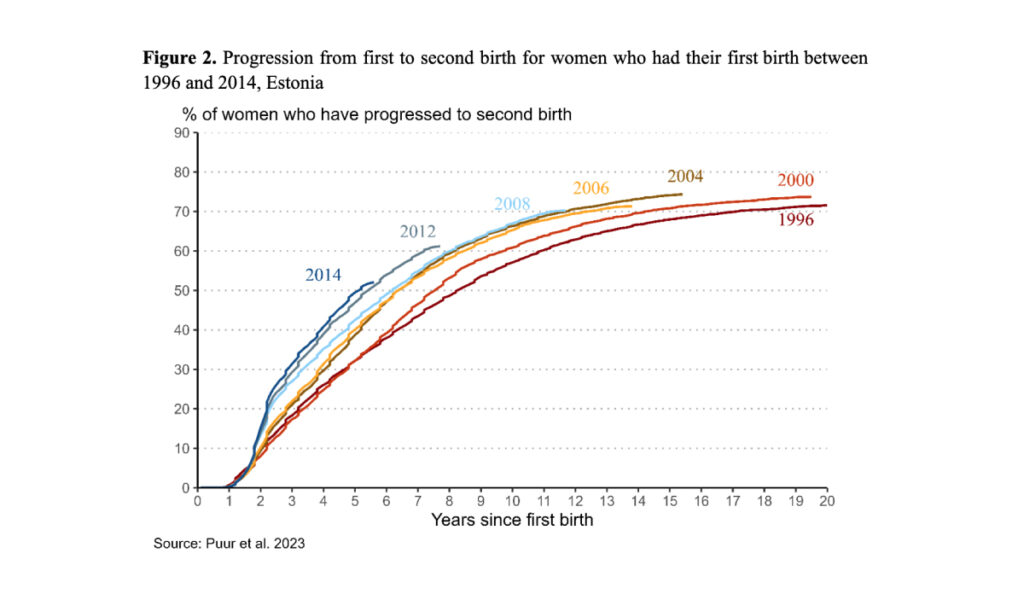
The number of countries that aim to raise fertility has markedly increased over recent decades. Among policy instruments used to achieve this goal, parental leave schemes play an important role. Allan Puur, Sanan Abdullayev, Martin Klesment and Mark Gortfelder analyse the case of Estonia and find a positive impact of the generous parental leave reform on the transition to second and third births.
The gap between intended and actual levels of fertility is large in countries with low fertility levels, which suggests that people often fail to achieve their desired number of children (Beaujouan & Berghammer, 2019). Earnings-related parental leave (PL) is seen as an important policy measure that may contribute to reducing this gap by allowing parents to take time off work to care for a young child, with a guaranteed return to their job, and by decreasing the costs of having a child. However, findings on the effect of PL on fertility are mixed (Sobotka, Matysiak & Brzozowska, 2020).
What about Estonia? In a recent paper, using longitudinal register-based data covering childbearing histories between 1993 and 2020, we studied the effects of a generous new earnings-related PL scheme on the transition to second and third births, in terms of timing and probability of having a next child (Puur et al., 2023).
The 2004 parental leave reform in Estonia
In 2004 in Estonia, PL with low flat-rate benefits was replaced with a generous earnings-related scheme. The new scheme offers benefits equal to 100% of pre-birth income with a high ceiling (three times the average salary). Parents with pre-birth income below or equal to minimum wage receive benefits equal to the minimum wage. Those without income prior to birth receive a flat-rate benefit slightly below the minimum wage. The duration of payment was initially 11 months, and had increased to 18 months by 2008.
Another important feature of the new PL scheme is the so-called speed premium. This allows parents to maintain the same level of parental benefit if the interval between successive births is less than 30 months. Thanks to these features, Estonia now has one of the world’s most generous PL schemes (Otto et al., 2021).
Faster transition to the next birth after the reform
Corroborating findings from Sweden (Hoem, 1993) and Austria (Lalive & Zweimüller, 2009), we found that parents responded to the speed premium by reducing birth intervals. At a duration of less than 30 months since the first birth, the eligibility period for continuing to receive the same level of PL benefit, second birth rates clearly increased among women who had their first birth in 2003 and later (Figure 1). By contrast, there was almost no change at a slightly longer duration of 31–36 months for second births during the observation period, which suggests a noticeable effect of the speed premium.

Interestingly, fertility in the eligibility period of the speed premium did not increase immediately after the reform, but rose slowly over several years, probably because many parents behaved strategically to strengthen their position in the labour market before having another child, in order to receive higher PL benefits. Another factor behind the observed pattern might be the progressive extension of the duration of paid PL in 2006 and 2008.
Higher progression to the next birth after the reform
To detect changes in fertility levels associated with the PL reform, we examined the progression to the next birth among parity cohorts, i.e. women who had their previous birth in a given year. To identify whether a policy is effective, it is necessary to focus on critical changing points, where specific cohorts are “exposed” to the reform under scrutiny. Figure 2 shows, for instance, that the 1996 and 2000 cohorts exhibit almost the same pattern by duration until when the 2000 cohort became exposed to the reform, some five years after the first birth. At this point, this cohort of mothers started to show more rapid progression to their second birth. The divergence widened until the eighth year, when the 1996 cohort also became exposed to the reform.

The following parity cohorts, who were exposed to the reform immediately after their first birth, already show more rapid progression to the second birth at short durations. For instance, the difference between the 2004 and 1996 cohorts widens until the 8th year (when the 1996 cohort was also exposed to the reform), reaching almost 10 percentage points. These findings suggest that the PL reform not only shortened birth intervals but also increased the probability of the next birth. The results for third births, not reported here, are similar, although less pronounced.
To ascertain that the observed changes in fertility behaviour are due to the PL reform and not to other factors such as improvement in economic conditions or changes in the population composition, we controlled for several individual and macro-level factors using mixture cure models. Contrary to standard event history models, these models allowed us to separate the effect of the policy reform on the propensity to have another child from its effect on timing. The modelling results supported the above findings. The probabilities of a second and third birth were found to be 6 and 4 percentage points higher, respectively, in the post-reform period (2004–2019) compared to the pre-reform period (1993–2004). The interval to second and third birth shortened by 12% and 15%, respectively, from the pre-reform to the post-reform period.
Conclusions
Our study suggests that, in Estonia, generous earnings-related PL has been effective in stimulating transitions to the next birth, in terms of both tempo and quantum of fertility. The number of children ever born increased from 1.83 among women born in 1970 to 1.91 among women born in 1977–1978. This increase in completed fertility was caused by the rise in second and third births, more than compensating for the increase in childlessness and the decrease in higher-order births.
In a broader context, our results support a recent reappraisal of the impact of PL reforms by Bergsvik et al. (2021), who concluded that generous job-protected parental leave may have larger effects on fertility than previously thought, especially when public childcare is readily available. Furthermore, our study highlights that the positive effect of the parental leave scheme on fertility depends on several key features, such as continued high benefit levels when births are closely spaced, and sufficient length of leave, to allow parents to take advantage of the speed premium.
References
- Beaujouan, E., & Berghammer, C. (2019). The Gap Between Lifetime Fertility Intentions and Completed Fertility in Europe and the United States: A Cohort Approach. Population Research and Policy Review, 38(4), 507–535. https://doi.org/10.1007/s11113-019-09516-3
- Bergsvik, J., Fauske, A., & Hart, R. K. (2021). Can Policies Stall the Fertility Fall? A Systematic Review of the (Quasi-) Experimental Literature. Population and Development Review, 47(4), 913–964. https://doi.org/10.1111/padr.12431
- Hoem, J. M. (1993). Public Policy as the Fuel of Fertility: Effects of a Policy Reform on the Pace of Childbearing in Sweden in the 1980s. Acta Sociologica, 36(1), 19–31. https://doi.org/10.1177/000169939303600102
- Lalive, R., & Zweimüller, J. (2009). How Does Parental Leave Affect Fertility and Return to Work? Evidence from Two Natural Experiments. The Quarterly Journal of Economics, 124(3), 1363–1402. https://doi.org/10.1162/qjec.2009.124.3.1363
- Otto, A., Bártová, A., & Lancker, W. V. (2021). Measuring the Generosity of Parental Leave Policies. Social Inclusion, 9(2), 238–249. https://doi.org/10.17645/si.v9i2.3943
- Puur, A., Abdullayev, S., Klesment, M., & Gortfelder, M. (2023). Parental Leave and Fertility: Individual-Level Responses in the Tempo and Quantum of Second and Third Births. European Journal of Population, 39(1), 22. https://doi.org/10.1007/s10680-023-09669-0
- Sobotka, T., Matysiak, A., & Brzozowska, Z. (2020). Policy responses to low fertility: How effective are they? UNFPA.
No comments:
Post a Comment